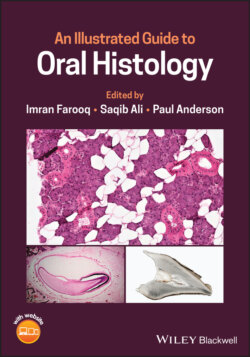Читать книгу An Illustrated Guide to Oral Histology - Группа авторов - Страница 10
Оглавление
Sample Preparation
This atlas contains images obtained through hematoxylin and eosin (H and E) staining, micro‐computed tomography (micro‐CT), ground sectioning, and scanning electron microscopy (SEM). The steps for the preparation of samples and collection of images are as follows.
Hematoxylin and Eosin (H and E) Stained Sections
The tissues were stored in 10% buffered formalin prior to their use. The hard tissue samples were decalcified in 8% formic acid. The tissues (hard and soft) were washed with distilled water and then transferred into alcohol solution for the dehydration procedure. Post‐dehydration, the samples were cleared in xylene solution. The tissues after clearing were shifted into soft paraffin and hard paraffin baths. The sections were blocked by embedding in hard paraffin and thin sections of 7 μm were taken from blocked tissues using microtome. H and E staining was performed, samples were dehydrated, and cover slips were placed using DPX mounting medium.
Micro‐computed Tomography (Micro‐CT)
The tissue blocks to observe enamel and dentin were prepared by cutting the roots with a high‐speed handpiece. The anatomical crown portion was retained and a micro‐CT machine (SkyScan 1172, version 1.5; Bruker Micro‐CT, Kontich, Belgium) was used to obtain images of enamel and dentin. The images were obtained by scanning the samples using a voltage source of 100‐KV, source current of 100‐μA, pixel size of 27.45‐μm, and exposure time of 1600 msec. In addition, 360° rotation, filter of Al + Cu and, Tagged Image File Format (TIFF) were used. The raw images were recreated using the NRecon software (Bruker SkyScan, Aartselaar, Belgium). The TIFF images were later converted to Joint Photographic Experts Group (JPEG) format using Microsoft Paint® software.
Ground Sections
For each ground section preparation, freshly extracted teeth were collected and fixed in acrylic blocks. The teeth were sectioned using a water‐cooled diamond saw (Isomet® 5000 Linear Precision Saw, Buehler Ltd, IL, USA) longitudinally (for longitudinal sections) and horizontally (for transverse sections) to split the tooth into two parts. Each thick section of tooth was then grinded on carborundum stone with equal digital pressure to make the sections paper thin. The sections were then dehydrated in absolute alcohol for 10 minutes and clearing was then performed in xylene solution for 15 minutes. The section was mounted on to a glass slide using DPX mounting medium. Coverslip was then placed on top of the section carefully to avoid air entrapment.
Scanning Electron Microscopy
To observe dentinal tubules, SEM was performed. Dentin discs of 1.5 mm were first made by cutting the teeth horizontally over cemento‐enamel junction using a precision saw (Isomet® 5000 Linear Precision Saw, Buehler Ltd, IL, USA). The discs were exposed to ethylenediaminetetraacetic acid (EDTA) for one minute to unblock the dentinal tubules. After washing them with distilled water for one minute and post air drying, these discs were mounted on stubs and sputter coated with gold. The discs were observed in an SEM (FEI, Inspect F50, The Netherlands) to obtain micrographs of dentinal tubules.
